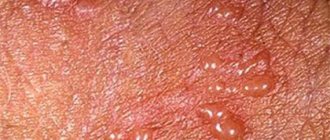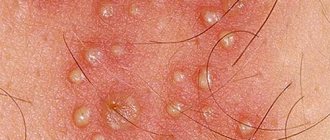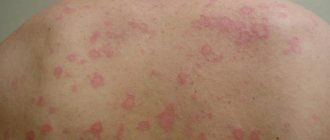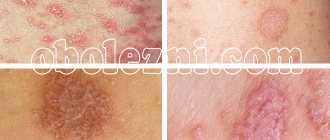If the ulcer is localized in a place inaccessible to inspection (in women - in the vagina, on the cervix), primary syphilis may remain undiagnosed.
And if left untreated, it will progress to the next stage.
Secondary syphilis is characterized by the appearance of rashes on the skin, as well as spots localized in the neck area.
They are called the “necklace of Venus” or syphilitic leucoderma (pigment syphilide).
The appearance of characteristic spots on the neck, shoulders or torso is due to the lack of therapy at an early stage of the disease.
Or the use of ineffective drugs that could not cope with the infection.
When a Venus necklace appears on the neck, this is evidence that treponema pallidum has already spread throughout the body.
If at this stage the cerebrospinal fluid is examined for the presence of spirochetes, the result will be positive.
This means that the central nervous system has been damaged.
Depending on the state of the immune system, external signs of the disease will appear or be absent.
What does Venus's necklace look like?
The Necklace of Venus is not a separate disease, but one of the symptoms of syphilis.
In the secondary period, patients develop syphilitic leukoderma.
It is also called pigmentary syphilide.
This is a disorder of skin pigmentation.
In the classic version, hypopigmented light spots appear.
They form on skin with signs of hyperpigmentation.
Due to this contrast, these spots are clearly visualized.
The most common localization of pigmentary syphilide is the back and side surface of the neck.
Hence the name of this symptom.
If you look at a photo of a Venus necklace on women, the light spots seem to be around the circumference of the neck.
There are three types of pigmentary syphilide.
- Spotted leukoderma.
There is a clearly expressed contrast between areas of the skin with increased and weakened pigmentation.
The zones of hyperpigmented areas are wide.
Light spots are usually small.
Located separately, without merging.
- Lace leucoderma.
The zones of hyperpigmentation are narrow.
Light-colored spots, on the contrary, are large and merge with each other.
- Marbled leukoderma.
There is minimal contrast between areas of hypo- and hyperpigmentation.
The skin looks dirty.
Despite the fact that the symptom is called the necklace of Venus, spots do not always appear exclusively on the neck.
They can also education on:
- breasts
- upper limbs
- in the armpit area
The Venus necklace symptom does not occur in all patients with syphilis.
It occurs more often in women than in men.
Danger for men
You need to start treating syphilis as early as possible, without delay. If you take this terrible disease lightly, the pathology progresses and leads to dire and terrible consequences.
Treponema pallidum penetrates all organs and over time destroys healthy tissue, causing necrosis (death) of individual areas. Signs of syphilis in men are clearly expressed at any stage of the disease, so diagnosis does not cause difficulties.
Syphilis on the penis is a severe pathology, which is accompanied by purulent-inflammatory processes. A syphilitic infection on the glans leads to necrosis, death of the foreskin and necrosis of the penis, followed by amputation. Syphilis infection greatly undermines a man’s immunity, so the risk of secondary infection increases significantly. The body weakens, can no longer fight microorganisms, and then any infections easily penetrate into it.
Almost every third man with syphilis is diagnosed with swelling of the penis and hardening of the foreskin. The man suffers pain, cannot do normal activities and experiences discomfort when moving. The disease affects the entire body as a whole, and not just the condition of the genital organs.
Why does a Venus necklace appear on the neck?
Scientists still do not know exactly the mechanism of formation of pigmentary syphilide.
There are several theories to explain this syndrome.
The main one says that this is a neurodystrophic process.
That is, changes in skin pigmentation are associated with damage to nervous tissue.
This is evidenced by the frequent combination of the necklace of Venus with neurosyphilis.
Almost always, accompanying changes in the spinal cord are found.
In addition, skin biopsy and histological examination indicate that nerves are damaged in the area of localization of areas of impaired pigmentation.
They reveal deep degenerative processes.
The remaining morphological changes in the skin correspond to those with syphilitic roseola.
Another theory explains the appearance of pigmentation by dysfunction of the adrenal glands.
Both an increase and a decrease in the level of glucocorticoid hormones leads to changes in skin color in various areas.
Reasons for development
Venus's belt is a typical sign of secondary syphilis. By this time, severe damage to internal organs begins, and the nervous system is one of the first to be hit.
Atrophy of nerve endings leads to a decrease in the sensitivity of the epidermis, disruption of metabolic processes in it, and nutrient deficiency. This is a direct path to a change in the pigment composition of the skin layers, expressed in the appearance of white spots (pigment deficiency) in individual cells and its excessive accumulation in others.
This reason is also confirmed by laboratory studies: in the analyzes studying these spots, there is no causative agent Lewis - the bacterium itself, while papular eruptions, roseola and chancre contain Treponema pallidum in excess. The only mystery, even for modern scientists, remains the fundamental location of the Venus necklace on the neck.
Necklace of Venus and accompanying symptoms
Syphilis has many symptoms.
But not all of them appear at the same time as the necklace of Venus.
Most often, syphilitic alopecia appears during the same period.
It is characterized by hair loss on the scalp.
There are three forms of baldness due to syphilis:
- Small focal alopecia.
This is a pathognomonic symptom of syphilis.
This type of baldness does not occur with other diseases.
The hair on your head looks like a moth-eaten fur coat.
Foci of baldness are localized mainly on the back of the head, crown, and temples.
Usually they are located chaotically.
There is no symmetry.
The average diameter of “bald” lesions is from one to one and a half centimeters.
They have a regular round shape.
There is no tendency to merge into large foci.
Usually they are located separately.
Not all hair falls out.
This syndrome also includes Fournier's sign.
This is the name for baldness that occurs on the beard, mustache, pubic area and eyebrows.
Another symptom is Pincus sign.
Eyelashes look like steps.
Because they fall out gradually as the pathological focus spreads.
They also grow gradually, which is reflected in the “ladder” structure.
- Diffuse alopecia.
Hair loss can occur evenly with syphilis.
Baldness begins at the temples.
In rare cases, a person completely loses hair.
Even vellus hair, eyebrows and eyelashes fall out.
- Mixed.
It is a combination of the two forms described above in one patient.
Alopecia due to syphilis goes away on its own within 3 months.
And under the influence of treatment - after 2 weeks.
Hair, of course, does not grow back in such a short period of time.
But their loss stops.
What it is?
This is a skin reaction to the presence of the Lewis pathogen in the body - Treponema pallidum. It is expressed in small-sized pigment spots covering the upper part of the body, and in rare cases – its central part.
This symptom appears several months after the infection enters the body and in medicine has a less romantic name: syphilitic leukoderma. This name was given to it by the German infectious disease specialist A. Neisser at the end of the nineteenth century, but the first descriptions of this symptom are more ancient, and its Latin name is more familiar to the ears of even modern doctors - venereologists.
Leucoderma has two more literary names: “Venus’s crown” or “Venus’s belt”.
In addition to spots covering the body of men and women in the décolleté and neck area, signs of syphilis also include similar symptoms spreading throughout the body, baldness (focal or diffuse), and syphilitic ulcers.
All these symptoms are part of the legend about the curse of the goddess Venus on the earthly youth, who decided to take revenge on him for his betrayal with gifts: a red shirt, a hat and a pearl necklace, which turned out to be the main signs of the disease.
How often is it associated with damage to the nervous system by syphilis?
When the Venus Necklace appears, the following are revealed:
- pathological changes in the cerebrospinal fluid
- dystrophic lesions of peripheral nerves in the area of spot formation
But spotted syphilide is rarely combined with neurosyphilis.
Because damage to the nervous system usually occurs no earlier than 2 years from the onset of the disease.
While the necklace of Venus appears on the body after 4-6 months, and disappears on average after six months to a year.
That is, a year and a half after infection it is no longer there.
Features of the course of leukoderma
Unlike other types of rashes that disappear after a few months, the crown of Venus remains on the patient’s body for a very long time, sometimes for years. Often such a belt is the only manifestation of syphilis, even in stable remission.
In the fairer sex, this phenomenon is diagnosed several times more often than in men, and this sexual preference is also a mystery to scientists.
It is possible to eliminate the symptom with the help of qualified treatment, but after its disappearance, traces of its presence remain for a couple of months.
Differential diagnosis for necklace of Venus
An experienced doctor always knows how to distinguish the necklace of Venus from other diseases.
Differential diagnosis of the necklace of Venus in medicine is carried out with the following pathologies:
- secondary leukoderma after treatment of dermatological diseases (psoriasis, lichen planus)
- pseudoleukoderma
- vitiligo
- Setton's nevus
- neurofibromatosis
Secondary leukoderma looks the same as syphilitic.
But its localization may be different.
The spots are often uneven.
They may appear on normal rather than hyperpigmented skin.
Anamnestic data also helps to understand the diagnosis.
The patient has a history of treatment for psoriasis or other skin diseases.
Pseudoleukoderma in pityriasis versicolor.
This is a disease caused by opportunistic fungi.
Reddish spots appear on light skin.
On dark skin they look white.
The skin may be dark due to insolation.
At the same time, areas affected by pityriasis versicolor do not tan.
Pityriasis versicolor differs in localization.
Spots usually form on the chest and back, and scalp.
Although in some cases the location coincides with the necklace of Venus.
With pityriasis versicolor, subjective sensations (itching) are sometimes observed, while with syphilitic leukoderma they are absent.
Vitiligo is depigmented areas of the skin.
It differs from pigment syphilide in its long course.
The stains persist for years.
They are completely white.
The hair on the affected areas also lacks pigment.
Setton's nevus is a large mole with hypopigmented spots near it.
It differs from the Venus necklace in the absence of the correct rounded shape of the elements.
An area of skin devoid of pigment is always located around the nevus, which is not the case with syphilis.
The pathology develops gradually.
It progresses over months.
While syphilitic leukoderma appears in 2-3 weeks.
Café au lait spots appear in neurofibromatosis type 1.
This is a hereditary disease.
It manifests itself even in childhood.
In addition to the spots, there are many other symptoms that are not present with syphilis.
This is a curvature of the spine, speech disorders, an increase in head circumference, etc.
Basic treatment methods
In case of leukopathy, it is important to be constantly monitored by a venereologist. The main type of treatment is Penicillin, and local medications are also used. The dosage is selected individually for each person. The main task is to constantly maintain the required dose of antibacterial drugs in the blood.
It is very important at the beginning of the development of the disease to administer potent drugs every 3 hours. It is especially dangerous when another rash appears, this indicates that the person is also infected with another virus.
In addition to prescribing potent drugs, it is necessary to take immunomodulators, vitamins, minerals, dietary supplements, which increase immunity and remove harmful microorganisms.
When the disease occurs in a complex form, special drugs and antibiotics must be administered intramuscularly. With their help you can dry, disinfect the skin, get rid of erosions and ulcers on the body.
It is important to constantly monitor the patient's condition. If the first regimen is ineffective, it is adjusted, and the medications and their dosage are changed. In addition, the patient must follow a diet and completely abandon all bad habits.
Both partners need to take medications, and all tests must be taken after treatment. In case of exacerbation, undergo a second course of therapy.
Blood tests for Venus necklace
Syphilis is diagnosed using laboratory tests.
Whatever necklaces or other external manifestations of this infection may be on a person’s body, they are not a sufficient basis for making a diagnosis.
Based on the symptoms, a syphilitic infection can only be suspected.
Further confirmation is required.
Various studies are used for this:
- ELISA
- RPGA
- REEF
- immunoblot and others
Confirmation of the diagnosis is usually possible after two different positive tests for syphilis.
The first is considered screening.
The second is confirmatory.
At the time when the Venus necklace appears, most tests for syphilis will already show this infection if it is present in the body.
Research methods are aimed at detecting antibodies to Treponema pallidum.
There are also non-treponemal tests.
They can be used as screening tests.
If the result is positive, confirmation is necessary using a treponemal test.
How can you become infected?
There are three main ways of contracting syphilis - sexual, household and medical . But being selective in choosing sexual partners, following the rules of personal hygiene, and basic neatness and cleanliness practically eliminates the possibility of infection.
- In 90% of cases, syphilis is contracted sexually - from a sick person, unknowingly entering into an intimate relationship with him. A condom does not provide a 100% guarantee.
- Syphilis is also transmitted through household means. Treponema pallidum is not viable, so it is extremely rare to become infected through everyday life. You can get syphilis if you use other people’s personal belongings: dishes, underwear, a towel. You can become infected in a bathhouse, sauna or swimming pool. It is not recommended to sit on the shelves without first placing a towel or sheet, and you should not walk on the floor without rubber slippers on your feet. It is advisable to ask the administrator how regularly the water and premises are disinfected.
- Another way is medical, in which the pathogen is transmitted through the blood. For example, if a patient donates blood for testing, then theoretically he can become infected. But in practice this is almost impossible, since disposable syringes are now used everywhere. You can become infected through a blood transfusion if treponema is present in the donor's blood. You can also become infected at a hairdresser or during dental treatment.
Necklace of Venus: how to treat
The presence of a Venus necklace indicates that the patient has secondary early syphilis.
Treatment is carried out with penicillin preparations.
Different schemes are used.
The most convenient regimen for the patient involves the use of durable penicillins.
They have a long-lasting effect.
Therefore, they are used once a week.
Retarpen is prescribed.
A total of 3 injections are required.
Single dose – 2.4 million units.
Other drugs are also used.
These are Bicillins 1, 3 and 5, procaine-penicillin, novocaine and sodium salts of penicillin.
Short-acting drugs are not very convenient for outpatient treatment.
Therefore, doctors often prefer medium- or long-acting drugs.
Syphilitic leucoderma
At the initial stage, syphilis manifests itself in the form of a small ulcer on the genitals or other part of the body where the pathogen has been introduced. A person who is inattentive to himself may well miss this symptom and see a doctor only after a few months, when the signs of secondary syphilis are already too noticeable. One of the symptoms is considered to be syphilitic leukoderma, or pigmentary syphilide. You can judge what this disease looks like from photographs of patients with secondary syphilis.
The appearance of light spots on the skin indicates that the pathogen has already spread throughout the body and penetrated into many organs. When examining the cerebrospinal fluid after visiting a doctor with complaints of leukoderma, changes are detected even in the central nervous system. But external symptoms may appear in a vague form, depending on the state of the person’s immune system.
Signs of the secondary stage of the disease
If the patient has not completed a course of therapy in a timely manner, and the primary stage of the pathology has progressed to the second, the rash takes on certain forms of skin lesions:
- Roseola syphilide. This form of syphilitic rash is more common in the secondary stage of the disease. The rash takes the form of medium-sized spots of a pinkish tint, covering mostly the epithelial tissues of the arms, abdomen and neck.
- Papular syphilide. This type of rash can develop at the secondary as well as at the tertiary stage of the pathology. In this situation, the rashes look like small round nodules with a smooth surface that sometimes peel off. The spots combine into rings and large plaques, similar to psoriasis of the palms and soles. In certain cases, syphilitic calluses and warts form over the papules. This rash primarily affects the genitals and anus of sick people.
- Palmoplantar syphilide. A rash of this type is characterized by the appearance on the body of numerous nodular neoplasms that are red in color and prone to peeling. In some situations, these rashes are mistaken for ordinary calluses, which do not awaken feelings of anxiety and fear in the sick person, and often a serious illness is not detected in a timely manner.
- Wide condylomas. A syphilitic rash that spreads mainly to the anal ring of infected people.
- Syphilitic leucoderma. A large number of red spots most often cover the patient’s neck and shoulders, which is why this type of rash is called the “necklace of Venus.”
- Erythematous tonsillitis. This type is a consequence of infection of the mucous membranes of the throat. Small spots of bright red or purple color appear on the tonsils and soft palate. They reach a size of 2 cm, unite and form plaques. Such spots occur in recurrent forms of the disease or when the disease passes into the tertiary stage. This type of rash is quite dangerous, because numerous bacteria are concentrated on the surface of the affected areas, which can easily enter the body of a healthy person through ordinary household means. Syphilides can cause a feeling of pain when swallowing, a feeling of dryness and regular soreness in the throat.
- Syphilitic alopecia. It spreads to areas of the skin where hairs are present, as a result of which the patient may lose part of the hair.










